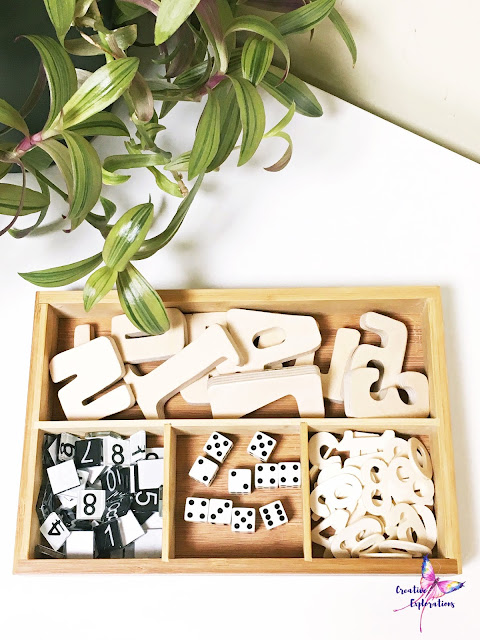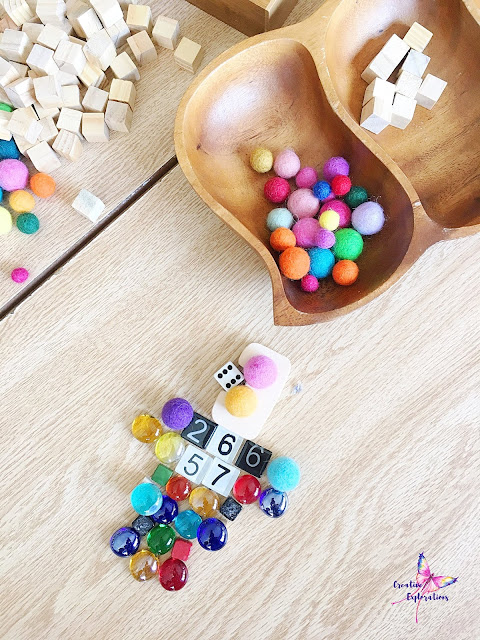"The Pure Mathematician,
like the Musician,
is a free Creator
of his world of ordered
Beauty."
Bertrand Russell
Young children are naturally inquisitive and it is this curiosity about the world around them that drives their initial engagement with materials in the learning environment. Keeping this in mind, the materials for our first mathematical offering this school year were carefully curated not only for their aesthetic properties but also their sensory capabilities. When a child's senses are activated learning takes place on a multi-facated level. The softness of the wool-felt balls, the smoothness of the glass gems and square tiles along with the sharp edges of the wooden cubes all inform the sense of touch and communicate to the child information about the properties and attributes of these materials. This beautiful 100 board from Mirus Toys had been on my wish list for quite some time. I purchased it this summer and I am delighted with the quality and beauty of this board. I will definitely be ordering again from Mirus Toys. It was packaged beautifully and I couldn't be happier with this product. This past week I offered the 100 board and the two loose part trays pictured in the photos to the children for exploration.
I am sharing some of the children's explorations and thinking while they engaged with the materials with a small group of peers. Through the documentation of their play the children's own ideas and mathematical thinking became visible. They were able to communicate through their words, the manipulation of materials and their interactions with peers their own thinking and mathematical theories. Their learning was built and shared through the children's interactions with each other. As ideas emerged some were challenged by peers and others were guided and pushed to new understandings in response to the materials. Here's a peek at the depth of the children's explorations and creativity within the art of mathematical thinking. I hope that you find it as fascinating as I did.
"I made a robot that is flying in the air that has lots of jets and can shoot fireworks. It is eating 16 dices at once. That's the number of the robot. There are billions of robots with different numbers. This one is 2, 66, 57."
"Is this a 6?" This child rolled the die counted the dots on top of the die and then located the wooden numeral six in the tray before asking her question. A peer verified that indeed it was a six. Next she found another smaller six and placed it beside the die. She continued exploring the tray this time it was to find the tile with the number six on it. The tile was placed beneath the row of square tiles."
This photo documents two children's exploration of the materials. It began with the one-to-one correspondence of the wooden cubes and the square tiles placed all in a row. Next they worked together using the 100 board. They placed one of the materials after selecting it from the tray in each of the spots on the board. Initially they began to count from 1 to 10 but then continued with the filling the board without counting. Below the row of wooden numbers a puppy is designed by one of the children. She shared, "So two eyes, two feet, two hands. Oh this can be a puppy. How about, we might need these, pom poms, cubes and little small decorations." This exploration was rich in math talk which was communicated as this child created with the materials; naming three-dimensional figures, labeling size, and counting were shared.
Many children rolled the die and then counted out objects. Adding the wooden numbers after counting how many; communicated the total amount of objects used by this child.
After placing each die on the table and counting the dots on top the corresponding number tile was placed by each die. This child shared, "I put them all together and the number." She concluded her exploration by placing the square tiles on top of the dice and number tiles creating identical sets of objects.
Several of the children counted out the gems in a line. After counting to 12 this child said to his peer, "I have one more than you." He continued to add one gem and recount his row stating the amount counted at the end. This continued until he reached 15. Then he shared, "Oh my I have 15!" The long row of number tiles was created and then the child asked, "What number is this?"
"Miss it's equal." She placed two rows of five filled with gems going down the 100 board. This child pointed to each gem and counted to five. Then she added more gems to one of the rows. "Now it's not equal. This one has 8 and that one has 5. They are not the same amount. If I add one more it's six." She continued and added two more gems and shared, "There are 8 and now and it's equal." The exploration continued until there were two rows of 10 filled with gems on the 100 board. She concluded and shared the following, "If you put them all in one row it's 10."
After asking for a piece of paper and a pencil the numerals 1 to 10 were recorded before exploring the loose parts and the 100 board together. She selected the glass gems from the tray and placed them in the perimeter of the board. Then she continued to fill in the interior row with gems beside the outside row creating two squares one inside of the other. Next this child shared as she pointed to each of the rows of gems she created, "Miss 2 rows 2 on each side. Twenty." Her design continued and the square tiles were chosen to indicate the square shape of the interior space of the board.
Certainly the relationship between the materials, the children and their mathematical thinking were alive and visible. We will be reflecting on the documentation captured during this exploration with the children. As they share with each other the photos and their thinking the mathematical processes, language skills and artistic designs they engaged in will serve to teach, inspire and develop new ideas moving forward.
Looking forward to extending this learning!
Wishing you many creative explorations!
































